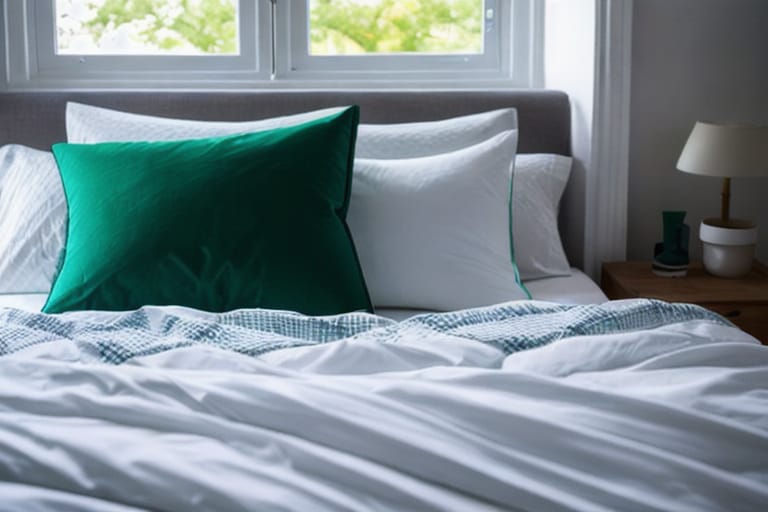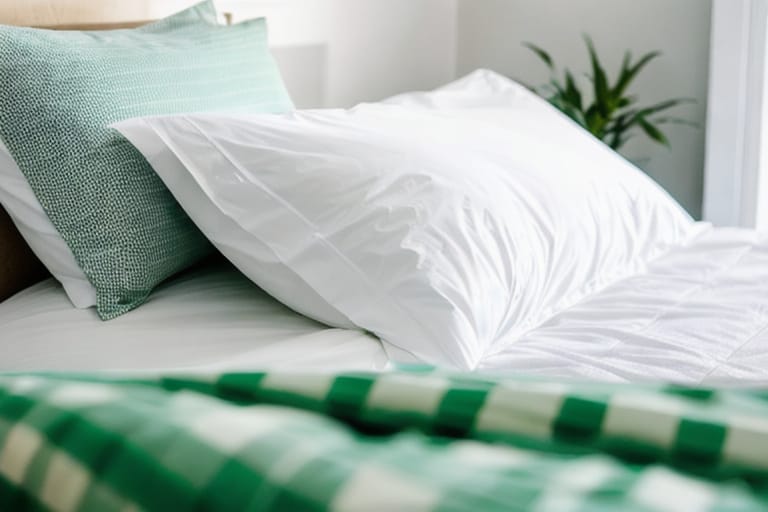Down comforters are known for providing unbeatable warmth and luxury. But many assume they primarily come in plain white. In reality, down comforters come in a rainbow of colors and patterns to match any bedroom décor.
What is a Down Comforter?
A down comforter is filled with fluffy clusters and soft plumage from ducks and geese called down feathers. Down clusters provide lofty insulation by trapping air between the feathers. Unlike quills and other hard feathers, down feathers don’t contain shafts. This allows them to compress together tightly for efficient warmth.
Down comforters are usually covered in an outer shell made from a woven fabric like cotton sateen. The fill and shell work together to create a plush blanket ideal for cold nights.
Below we’ll explore whether all down comforters are white, what impacts color, quality indicators, top brands, care instructions, and alternatives.
The Origins of White Down Comforters
For decades, white has been the traditional color for down comforters and most bedding. But this tradition has more to do with cultural norms than the properties of down itself.
Historical Use of White Bedding
In Western cultures, plain white bed linens were a status symbol historically only affordable by the elite. The white aesthetic conveyed cleanliness, simplicity and luxury.
As mass production made down bedding more accessible over time, consumers associated white with the pampered feel of 5-star hotels and high-end stores like Peacock Alley. So white down comforters became the standard.
Symbolic Meaning of White
Culturally, the color white represents purity, innocence, and minimalism in home decor. To this day, light hues like white, cream and ivory remain the most popular bedding colors. They blend seamlessly into a room without competing with other furnishings.
So while white down comforters are not mandatory, their soothing, neutral aesthetic persists in modern bedrooms.
What Impacts Down Comforter Color?
The natural color of down feathers and manufacturing processes determine the resulting comforter color.
Natural Down Color
In their organic state, down clusters and feathers range from creamy white to light beige or grey. The exact shade depends on factors like the age of the birds and the environment. Farmers even selectively breed to produce birds with consistent coloring.
So by nature, light colored down lends itself to white and neutral toned bedding.
Bleaching and Dyeing
Most down goes through bleaching to remove any discoloration and brighten the inherent light color. Manufacturers can also add dyes to produce down comforters in bolder secondary shades. But vivid dark hues are difficult to achieve.
The outer shell fabric also accepts dyes well, allowing for colorful exteriors like red gingham or navy blue flannel.
So while pure white down exists, processing enables diverse color options.
Down Comforter Quality Indicators
While a down comforter’s color is a personal preference, its construction determines its true quality:
Fill Power
Fill power measures the loft or fluffiness of down feathers. Higher fill equals better insulation from the same weight of down. Most quality comforters range from 600 to 900 fill power.
Fabric Shell
The outer shell encasing the down impacts durability. Tightly woven 100% cotton sateen fabric with a thread count of 300 or above works well.
Construction
Look for precision techniques like box-stitched construction or baffle boxes that keep down evenly distributed without shifting. Features like corner tabs also prevent the comforter from slipping inside a duvet cover.
High-end details certify an exceptional level of quality.

Responsible Sourcing Standards
Reputable brands adhere to ethical down certification programs and safety regulations:
Responsible Down Standard (RDS): Confirms humane treatment of geese and ducks.
Control Union: Independent verification of standards for materials used.
OEKO-TEX® STANDARD 100: Certifies textiles have no harmful substances.
Compliance guarantees the down comforter has ideal properties without compromising ethics.
Popular White Down Comforter Retailers
Many leading manufacturers offer white down comforters using premium materials and ethical methods.
Cuddledown White Goose Down Comforter
- Overview: Luxury style hotel collection comforter made in the USA
- Fill Power: 700 fill power European goose down
- Fabric: 300 thread count cotton sateen
- Features: Baffle box design, corner tabs
- Ethics: OEKO-TEX certified, RDS compliant
- The New York Times rated it their favorite white down comforter for lightweight warmth.
Peacock Alley Ultra Warmth White Down Comforter
- Overview: Heirloom-quality albino white goose-down bedding
- Fill Power: 650 fill power
- Fabric: Solid 410 thread count combed cotton
- Features: Gusseted sides, piped edges
- Ethics: RDS certified material
- Wirecutter’s top pick for winter warmth retention.
Authenticity50 Hungarian White Goose Down Comforter
- Overview: Classic style reversible solid white down comforter
- Fill Power: 750 fill power pure Hungarian goose down
- Fabric: 300 thread count 100% cotton cover
- Features: Baffle box stitching, corner loops
- Ethics: RDS verification available
- Sleep Like The Dead awarded it their “Best Down Comforter” distinction.
So while white remains popular, consumers have more choice than ever before.
Caring for a White Down Comforter
To prolong a down comforter’s lifespan, specialty care is advised:
- Cleaning: Only spot clean stains with a damp cloth and mild detergent.
- Drying: Air dry thoroughly if damp then redistribute filling by massaging lightly.
- Storing: During warmer months, store folded in a breathable cotton bag.
With gentle handling, a quality white down comforter can last over 20 years.
Addressing Down Shortages
In recent years, stock problems due to supply chain turmoil have impacted the availability of white down comforters. Limited inventory has also driven prices higher.
Industry Responses
Leading manufacturers like Cuddledown have increased wages to retain skilled workers from sourcing to production. They are also expanding collaboration with suppliers, farms, and certification agencies. These measures aim to stabilize the comforter supply chain.
Looking Ahead
Industry experts remain confident stocks will replenish as post-pandemic operations normalize. So white down comforter shortages should fully resolved within the next year.
Wool and Down Alternatives
For those seeking non-white or down-free comforters, alternatives exist:
Wool Comforters
Aussie wool company Authenticity50 makes a Climate Beneficial Wool Duvet Insert with moisture-wicking, thermoregulating wool sourced from sustainable farms.
Down Alternative Comforters
Down alternatives mimic feathers using polyester, rayon or other synthetic fills. Brands like Hotel Collection offer affordably priced models with hypoallergenic and vegan options. However, most down alternative comforters don’t match the plush feel and longevity of real goose down.
So sustainable materials like wool provide excellent alternatives to standard white down.
The Science Behind Cozy Comfort
Engineers apply thermal tech to build the ultimate snug bedding:
Comfort Temp Duvets use a smart fiber layering system for adjustable insulation. Sensors gauge body heat and humidity while you sleep. The duvet then regulates moisture and temperature accordingly using a control unit.
So while down itself is a thermal marvel, scientists keep improving comfort with ingenious innovations.
Matching with Decor and Personal Style
Beyond color, also factor in environmental ethics, care requirements, and sleeping needs when selecting a down comforter:
- Buy from manufacturers adhering to responsible standards like RDS
- Choose shell fabric that suits your climate’s humidity
- Compare fill power to unique warmth needs
- Select sizes accommodating mattresses up to 17” thick
- Consider how the color and style complement existing decor
- Invest in protectors and duvet covers to simplify cleaning
Then enjoy your beautiful down bedding for years on end!
The Bottom Line
While white down comforters maintain timeless appeal, improved dyes, ethical standards and creative designs empower more personalization than ever. With the right care and quality, down comforters produce incomparable comfort night after night, regardless of color.

Takeaways:
- Down comforters insulate using the soft plumage from ducks and geese
- Plain white bedding has historical and cultural ties to luxury
- Bleaching and dyeing processes allow diverse color options
- Fill power, shell fabric and construction determine quality
- Reputable brands meet responsible sourcing standards
- Proper storage and cleaning preserves lifespan
- Wool and down alternatives provide additional choices
- Personal style, decor, climate and ethics help guide preferences
Frequently Asked Questions
Are all down comforters white or do they come in other colors?
While white bedding is still common, improved dyes and processing methods now allow down comforters to come in many colors. Light colored down takes dyes well for beautiful shades of blue, green, pink or grey to suit your bedding tastes.
What is fill power and why does it matter?
Fill power indicates the fluffiness and thermal quality of the down feathers inside your comforter. Higher fill values like 700+ mean better insulation and lightweight warmth per ounce. Paying for quality high fill European goose down ensures superior cozy comfort.
How do I wash and care for a white down comforter properly?
Most outer shells and fabrics withstand gentle machine washing. But repeated spot cleaning only when necessary prolongs your comforter’s lifespan. Always fully air dry before storage or use to prevent moisture damage to down.
Where can I buy an ethical down comforter?
Top brands like Authenticity50 and Cuddledown use RDS verified down confirming humane treatment plus OEKO-TEX screened materials. Checking for respected certifications and standards ensures your purchase aligns with responsible sourcing.
Why choose a down comforter over synthetic alternative?
While cheaper to produce, no manmade fill matches the cloud-like comfort of goose or duck down feathers. Alternatives like microfiber lack the same warming loft and longevity over decades. So real goose down remains the gold standard for cozy, quality bedding.
How do I pick the right size down comforter?
Choose your comforter’s length, width and thickness based on mattress dimensions, number of sleepers, and personal preferences. Oversize Queen comforters with corner loops work well to accommodate deeper mattresses while preventing shifting inside a duvet.
What’s the benefit of a baffle box design?
Internal baffle boxes made of fabric walls compartmentalize chunks of down filling evenly across. This prevents the feathers from clumping or shifting to the edges over time. So box stitching maintains that dreamy down distribution for balanced comfort and maximum loft.








